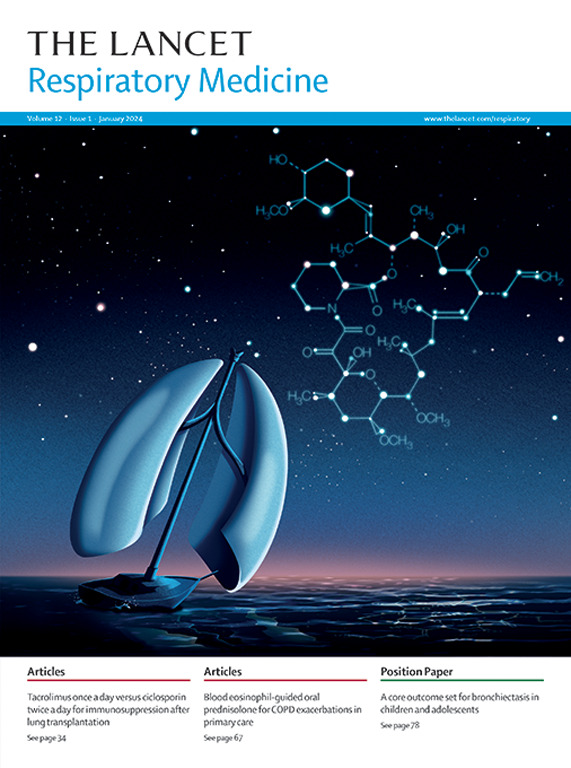使用新评分(MiDAS)评估多重发病对难治性哮喘的影响:一项哮喘队列的多国研究
IF 32.8
1区 医学
Q1 CRITICAL CARE MEDICINE
引用次数: 0
摘要
背景:多病(即两种或两种以上健康状况共存)在难治性哮喘患者中非常普遍。然而,目前尚不清楚在这些患者中,多病与疾病严重程度和不良健康结果之间的关系,以及哪些合并症是最重要的。我们的目标是通过开发一种以患者为中心的、临床描述性的难治性哮喘多病评分来解决这一知识差距。方法:我们使用来自英国威塞克斯难治性哮喘队列(WATCH;n=500,数据收集于2015年4月22日至2020年4月1日),以制定多病性哮喘评分(MiDAS)。最初,我们在WATCH中创建了一个改进的哮喘严重程度评分系统(m- evaluate)。然后,我们进行了单变量关联分析,以检验WATCH中13种最常见的合并症与m- evaluate之间的关联,并使用分支结合方法选择最相关的合并症纳入MiDAS。我们计算了所有在WATCH中拥有完整信息的患者的MiDAS值(n=319),并评估了它们与m-ASSESS成分、促炎生物标志物和圣乔治呼吸问卷(SGRQ)评分(一种生活质量衡量指标)的相关性。我们还在四个国际队列中评估了MiDAS与多个临床结果的关联:两个来自澳大利亚(n=236,数据收集于2014年6月14日至2022年4月1日;一个来自东南亚(n=151, 2017年3月21日至2024年1月16日),一个来自美国(n=100, 2021年7月9日至2023年12月14日)。研究结果:我们选择了7种常见的合并症(即鼻炎、胃食管反流病、呼吸模式障碍、肥胖、支气管扩张、非甾体抗炎药加重的呼吸系统疾病和阻塞性睡眠呼吸暂停),在分支结合分析的基础上纳入MiDAS,并使用多元线性回归将它们结合起来,得出与WATCH中m-ASSESS相关的MiDAS模型。MiDAS评分范围为9.6 ~ 16.2分。在WATCH成员中,平均MiDAS值为11.97 (SD为1.21),MiDAS与哮喘控制不良(τ= 0.31 [95% CI 0.24 - 0.38])和恶化(τ= 0.16[0.08 - 0.24])的m-ASSESS成分名义上相关。MiDAS还与WATCH患者较差的SGRQ总评分(r= 0.39 [95% 0.28 - 0.49], p< 0.0001)、促炎血浆细胞因子白细胞介素(IL)-4 (r= 0.19 [95% CI 0.06 - 0.31], p= 0.0036)、IL-5 (r= 0.35 [0.24 - 0.46], p< 0.0001)、瘦素(r= 0.29 [0.17 - 0.40], p< 0.0001)相关。四个国际队列的MiDAS值与WATCH(英国队列)相似,澳大利亚队列的平均值为12.33(标准差1.47)和12.31(标准差1.37),美国队列为11.80(标准差1.20),新加坡队列为11.55(标准差1.23)。在这些队列中,MiDAS与较差的哮喘控制、较差的生活质量、焦虑、抑郁和炎症增加相关。解释:midas强调了难治性哮喘的多重发病与最坏结局的共同发生。这些发现强烈表明,以气道为中心的方法是不够的,整体和多学科的护理是必要的。这种临床评分可以帮助临床医生识别多病风险最大的患者。资助:英国国家健康和护理研究所、澳大利亚国家健康和医学研究委员会、亨特医学研究所、纽卡斯尔大学(澳大利亚)和约翰·亨特医院慈善信托基金。本文章由计算机程序翻译,如有差异,请以英文原文为准。
Evaluation of the effect of multimorbidity on difficult-to-treat asthma using a novel score (MiDAS): a multinational study of asthma cohorts
Background
Multimorbidity (ie, co-existence of two or more health conditions) is highly prevalent in patients with difficult-to-treat asthma. However, it remains unclear how multimorbidity correlates with disease severity and adverse health outcomes in these patients and which comorbidities are most important. We aimed to address this knowledge gap by developing a patient-centred, clinically descriptive multimorbidity score for difficult-to-treat asthma.Methods
We used data from the UK-based Wessex Asthma Cohort of Difficult Asthma (WATCH; n=500, data collected between April 22, 2015, and April 1, 2020) to develop the Multimorbidity in Difficult Asthma Score (MiDAS). Initially, we created a modified Asthma Severity Scoring System (m-ASSESS) in WATCH. We then conducted univariate association analysis to test the association between the 13 commonest comorbidities and m-ASSESS in WATCH and used a branch-and-bound approach to select the most relevant comorbidities for inclusion in MiDAS. We calculated MiDAS values for all patients with complete information in WATCH (n=319) and assessed them for correlation with components of m-ASSESS, proinflammatory biomarkers, and St George's Respiratory Questionnaire (SGRQ) score, a quality-of-life measure. We also assessed the association of MiDAS with multiple clinical outcomes in four international cohorts: two from Australia (n=236, data collected between June 14, 2014, and April 1, 2022; and n=140, Aug 6, 2012, to Oct 18, 2016), one from southeast Asia (n=151, March 21, 2017, to Jan 16, 2024), and one from the USA (n=100, July 9, 2021, to Dec 14, 2023).Findings
We selected seven common comorbidities (ie, rhinitis, gastro-oesophageal reflux disease, breathing pattern disorder, obesity, bronchiectasis, non-steroidal anti-inflammatory drug-exacerbated respiratory disease, and obstructive sleep apnoea) for inclusion in MiDAS on the basis of the branch-and-bound analysis and combined them using multivariate linear regression to derive a MiDAS model associated with m-ASSESS in WATCH. The range of MiDAS scores was 9·6–16·2. In WATCH members, mean MiDAS value was 11·97 (SD 1·21) and MiDAS was nominally correlated with m-ASSESS components of poor asthma control (τ=0·31 [95% CI 0·24–0·38]) and exacerbations (τ=0·16 [0·08–0·24]). MiDAS was also correlated with worse total SGRQ score (r=0·39 [95% 0·28–0·49], p<0·0001) and with the proinflammatory plasma cytokines interleukin (IL)-4 (r=0·19 [95% CI 0·06–0·31], p=0·0036), IL-5 (r=0·35 [0·24–0·46], p<0·0001), and leptin (r=0·29 [0·17–0·40], p<0·0001) in WATCH. MiDAS values across the four international cohorts were similar to those of WATCH (UK cohort), with mean values of 12·33 (SD 1·47) and 12·31 (1·37) in the Australian cohorts, 11·80 (1·20) in the USA cohort, and 11·55 (1·23) in the Singapore cohort. In these cohorts, MiDAS correlated with worse asthma control, worse quality of life, anxiety, depression, and increased inflammation.Interpretation
MiDAS highlights the co-occurrence of multimorbidity with the worst outcomes in difficult-to-treat asthma. These findings strongly indicate that an airway-centric approach is inadequate and that holistic and multidisciplinary care is imperative. This clinical score could help clinicians to identify patients most at risk from their multimorbidity.Funding
UK National Institute for Health and Care Research, Australian National Health and Medical Research Council, Hunter Medical Research Institute, University of Newcastle (Australia), and John Hunter Hospital Charitable Trust.求助全文
通过发布文献求助,成功后即可免费获取论文全文。
去求助
来源期刊

Lancet Respiratory Medicine
RESPIRATORY SYSTEM-RESPIRATORY SYSTEM
CiteScore
87.10
自引率
0.70%
发文量
572
期刊介绍:
The Lancet Respiratory Medicine is a renowned journal specializing in respiratory medicine and critical care. Our publication features original research that aims to advocate for change or shed light on clinical practices in the field. Additionally, we provide informative reviews on various topics related to respiratory medicine and critical care, ensuring a comprehensive coverage of the subject.
The journal covers a wide range of topics including but not limited to asthma, acute respiratory distress syndrome (ARDS), chronic obstructive pulmonary disease (COPD), tobacco control, intensive care medicine, lung cancer, cystic fibrosis, pneumonia, sarcoidosis, sepsis, mesothelioma, sleep medicine, thoracic and reconstructive surgery, tuberculosis, palliative medicine, influenza, pulmonary hypertension, pulmonary vascular disease, and respiratory infections. By encompassing such a broad spectrum of subjects, we strive to address the diverse needs and interests of our readership.
 求助内容:
求助内容: 应助结果提醒方式:
应助结果提醒方式:


